Femtosecond Green Light Generation Using a MgO-Doped Periodically Poled Lithium Niobate Crystal Pumped by a Yb-Doped Fiber Laser
Abstract
:1. Introduction
2. Experimental Setup
3. Results and Discussion
4. Conclusions
Author Contributions
Funding
Institutional Review Board Statement
Informed Consent Statement
Data Availability Statement
Conflicts of Interest
References
- Ideguchi, T.; Poisson, A.; Guelachvili, G.; Hänsch, T.W.; Picqué, N. Adaptive dual-comb spectroscopy in the green region. Opt. Lett. 2012, 37, 4847. [Google Scholar] [CrossRef] [PubMed] [Green Version]
- Chaitanya Kumar, S.; Parsa, S.; Ebrahim-Zadeh, M. Fiber-laser-based, green-pumped, picosecond optical parametric oscillator using fan-out grating PPKTP. Opt. Lett. 2016, 41, 52. [Google Scholar] [CrossRef] [PubMed] [Green Version]
- Malinauskas, M.; Zukauskas, A.; Hasegawa, S.; Hayasaki, Y.; Mizeikis, V.; Buividas, R.; Juodkazis, S. Ultrafast laser processing of materials: From science to industry. Light Sci. Appl. 2016, 5, e16133. [Google Scholar] [CrossRef] [PubMed] [Green Version]
- Hadden, J.P.; Bharadwaj, V.; Sotillo, B.; Rampini, S.; Osellame, R.; Witmer, J.D.; Jayakumar, H.; Fernandez, T.T.; Chiappini, A.; Armellini, C.; et al. Integrated waveguides and deterministically positioned nitrogen vacancy centers in diamond created by femtosecond laser writing. Opt. Lett. 2018, 43, 3586. [Google Scholar] [CrossRef] [PubMed] [Green Version]
- Rankin, B.R.; Kellner, R.R.; Hell, S.W. Stimulated-emission-depletion microscopy with a multicolor stimulated-Raman-scattering light source. Opt. Lett. 2008, 33, 2491. [Google Scholar] [CrossRef]
- Maher, M.-A.; Malinauskas, M.; Chiao, J.-C.; Purlys, V.; Rutkauskas, M.; Resnick, P.J.; Gadonas, R. Two-photon polymerization for fabrication of three-dimensional micro- and nanostructures over a large area. Proc. SPIE 2009, 7204, 72040C. [Google Scholar] [CrossRef]
- He, J.; He, J.; Xu, X.; Du, B.; Xu, B.; Liao, C.; Bai, Z.; Wang, Y. Single-mode helical Bragg grating waveguide created in a multimode coreless fiber by femtosecond laser direct writing. Photonics Res. 2021, 9, 2052. [Google Scholar] [CrossRef]
- Tabrizi, S.; Cao, Y.; Cumming, B.P.; Jia, B.; Gu, M. Functional Optical Plasmonic Resonators Fabricated via Highly Photosensitive Direct Laser Reduction. Adv. Opt. Mater. 2016, 4, 529. [Google Scholar] [CrossRef]
- Rekštytė, S.; Žukauskas, A.; Purlys, V.; Gordienko, Y.; Malinauskas, M. Direct laser writing of 3D polymer micro/nanostructures on metallic surfaces. Appl. Surf. Sci. 2013, 270, 382. [Google Scholar] [CrossRef]
- Nyushkov, B.N.; Trashkeev, S.I.; Klementyev, V.M.; Pivtsov, V.S.; Kobtsev, S.M. Generation of harmonics and supercontinuum in nematic liquid crystals. Quantum Elec. 2013, 43, 107. [Google Scholar] [CrossRef]
- Zafar, S.; Li, D.W.; Camino, A.; Chang, J.W.; Hao, Z.Q. High power supercontinuum generation by dual-color femtosecond laser pulses in fused silica. Chin. Phys. B 2021, in press. [Google Scholar] [CrossRef]
- Yu, H.H.; Zong, N.; Pan, Z.B.; Zhang, H.J.; Wang, J.Y.; Wang, Z.P.; Xu, Z.Y. Efficient high-power self-frequency-doubling Nd:GdCOB laser at 545 and 530 nm. Opt. Lett. 2011, 36, 3852. [Google Scholar] [CrossRef] [PubMed]
- Sun, G.C.; Lee, Y.D.; Li, B.Z.; Chen, X.T.; Zhao, M.; Wang, J.B.; Zhang, X.H.; Jin, G.Y. Efficient all solid-state CW yellow-green light source. Laser Phys. 2011, 21, 998. [Google Scholar] [CrossRef]
- Mortag, D.; Wandt, D.; Morgner, U.; Kracht, D.; Neumann, J. Sub-80-fs pulses from an all-fiber-integrated dissipative-soliton laser at 1 µm. Opt. Express 2011, 19, 546. [Google Scholar] [CrossRef]
- Jiang, T.X.; Cui, Y.F.; Lu, P.; Li, C.; Wang, A.M.; Zhang, Z.G. All PM Fiber Laser Mode Locked With a Compact Phase Biased Amplifier Loop Mirror. IEEE Photon. Technol. Lett. 2016, 28, 1786–1789. [Google Scholar] [CrossRef]
- Hao, Q.; Li, W.; Zeng, H. High-power Yb-doped fiber amplification system synchronized with a few-cycle Ti:sapphire laser. Opt. Express 2009, 17, 5815. [Google Scholar] [CrossRef]
- Turchinovich, D.; Liu, X.; Lægsgaard, J. Monolithic all-PM femtosecond Yb-fiber laser stabilized with a narrow-band fiber Bragg grating and pulse-compressed in a hollow-core photonic crystal fiber. Opt. Express 2008, 16, 14004. [Google Scholar] [CrossRef]
- Guo, Z.; Hao, Q.; Yang, S.; Liu, T.; Hu, H.; Zeng, H. Octave-Spanning Supercontinuum Generation From an NALM Mode-Locked Yb-Fiber Laser System. IEEE Photon. J. 2017, 9, 1–7. [Google Scholar] [CrossRef]
- Chaitanya, N.A.; Aadhi, A.; Singh, R.P.; Samanta, G.K. Type-I frequency-doubling characteristics of high-power, ultrafast fiber laser in thick BIBO crystal. Opt. Lett. 2014, 39, 5419. [Google Scholar] [CrossRef]
- Shukla, M.K.; Kumar, S.; Das, R. Single-pass, efficient type-I phase-matched frequency doubling of high-power ultrashort-pulse Yb-fiber laser using LiB3O5. Appl. Phys. B 2016, 122, 114. [Google Scholar] [CrossRef]
- Hong, C.; Sun, R.; Wang, Y.; Wang, P. Second harmonic generation based on a 1 μm femtosecond fiber CPA system. CLEO-PR 2017, s2020. [Google Scholar] [CrossRef]
- Chaitanya, N.A.; Aadhi, A.; Kumar, S.C.; Jabir, M.V.; Samanta, G.K.; Ebrahim-Zadeh, M. Frequency-Doubling of Femtosecond Pulses in “Thick” Nonlinear Crystals With Different Temporal and Spatial Walk-Off Parameters. IEEE Photon. J. 2016, 8, 1–13. [Google Scholar] [CrossRef]
- Hong, I.; Lee, K.; Lee, J.H. 532-nm second harmonic generation with enhanced efficiency using subharmonic cavity modulation-based quasi-Q-switched-mode-locked pulses. Opt. Express 2020, 28, 2543. [Google Scholar] [CrossRef] [PubMed]
- Lagatsky, A.A.; Rafailov, E.U.; Sarmani, A.R.; Brown, C.T.A.; Sibbett, W.; Ming, L.; Smith, P.G.R. Efficient femtosecond green-light source with a diode-pumped mode-locked Yb3+: KY(WO4)2 laser. Opt. Lett. 2005, 30, 1144. [Google Scholar] [CrossRef]
- Lagatsky, A.A.; Brown, C.T.A.; Sibbett, W.; Holmgren, S.J.; Canalias, C.; Pasiskevicius, V.; Laurell, F.; Rafailov, E.U. Efficient doubling of femtosecond pulses in aperiodically and periodically poled KTP crystals. Opt. Express 2007, 15, 1155. [Google Scholar] [CrossRef]
- Jeong, T.-Y.; Kim, S.-H.; Kim, G.-H.; Yee, K.-J. Visible-pulse generation in gain crystal of near-infrared femtosecond optical parametric oscillator. Opt. Express 2015, 23, 25620. [Google Scholar] [CrossRef]
- Huang, K.; Wang, Y.; Fang, J.; Chen, H.; Xu, M.; Hao, Q.; Yan, M.; Zeng, H. Highly efficient difference-frequency generation for mid-infrared pulses by passively synchronous seeding. High Power Laser Sci. Eng. 2021, 9, E4. [Google Scholar] [CrossRef]
- Fejer, M.M.; Magel, G.A.; Jundt, D.H.; Byer, R.L. Quasi-phase-matched second harmonic generation: Tuning and tolerances. IEEE J. Quantum Electron. 1992, 28, 2631. [Google Scholar] [CrossRef] [Green Version]
- Gayer, O.; Sacks, Z.; Galun, E.; Arie, A. Temperature and wavelength dependent refractive index equations for MgO-doped congruent and stoichiometric LiNbO3. Appl. Phys. B 2008, 91, 343. [Google Scholar] [CrossRef]
- Zelmon, D.E.; Small, D.L.; Jundt, D. Infrared corrected Sellmeier coefficients for congruently grown lithium niobate and 5 mol. % magnesium oxide–doped lithium niobate. J. Opt. Soc. Am. B 1997, 14, 3319. [Google Scholar] [CrossRef]
- Bach, F.; Mero, M.; Chou, M.-H.; Petrov, V. Laser induced damage studies of LiNbO3 using 1030-nm, ultrashort pulses at 10-1000 kHz. Opt. Mater. Express 2017, 7, 240. [Google Scholar] [CrossRef]
- Kan, H.; Zhang, S.; Zhai, K.; Ma, X.; Luo, Y.; Hu, M.; Wang, Q. Femtosecond-induced micostructures in Magnesium-doped Lithium Niobate crystals with high repetition rate. Opt. Commun. 2016, 361, 175. [Google Scholar] [CrossRef]
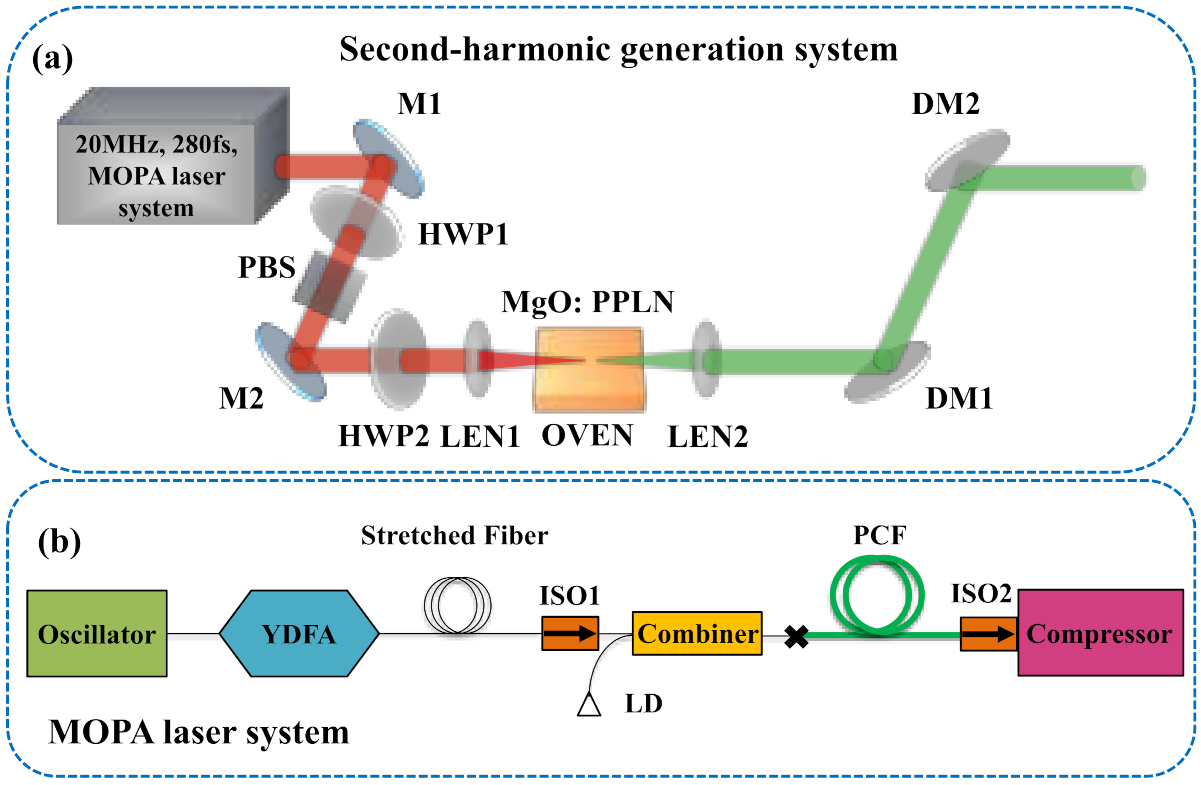
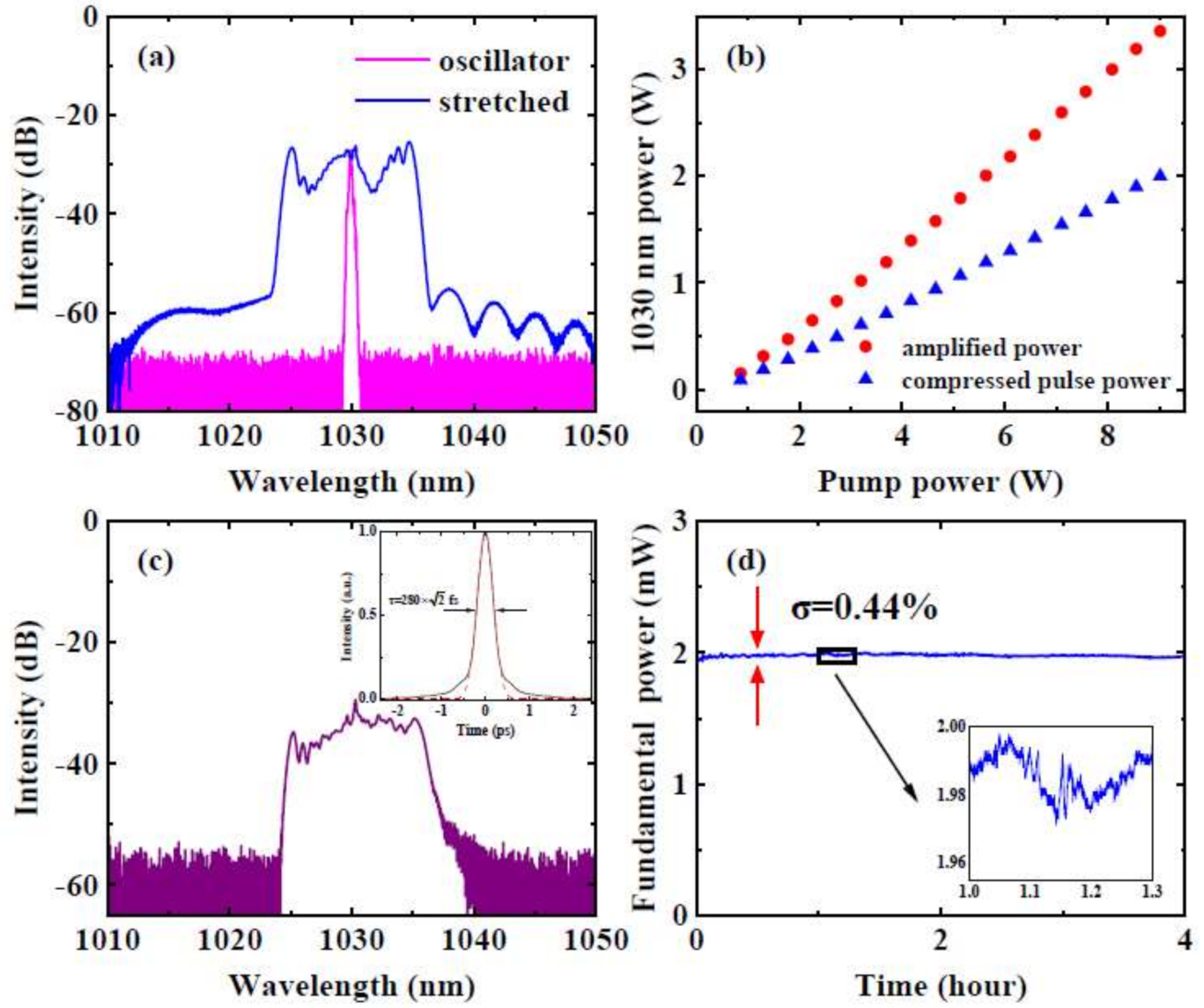
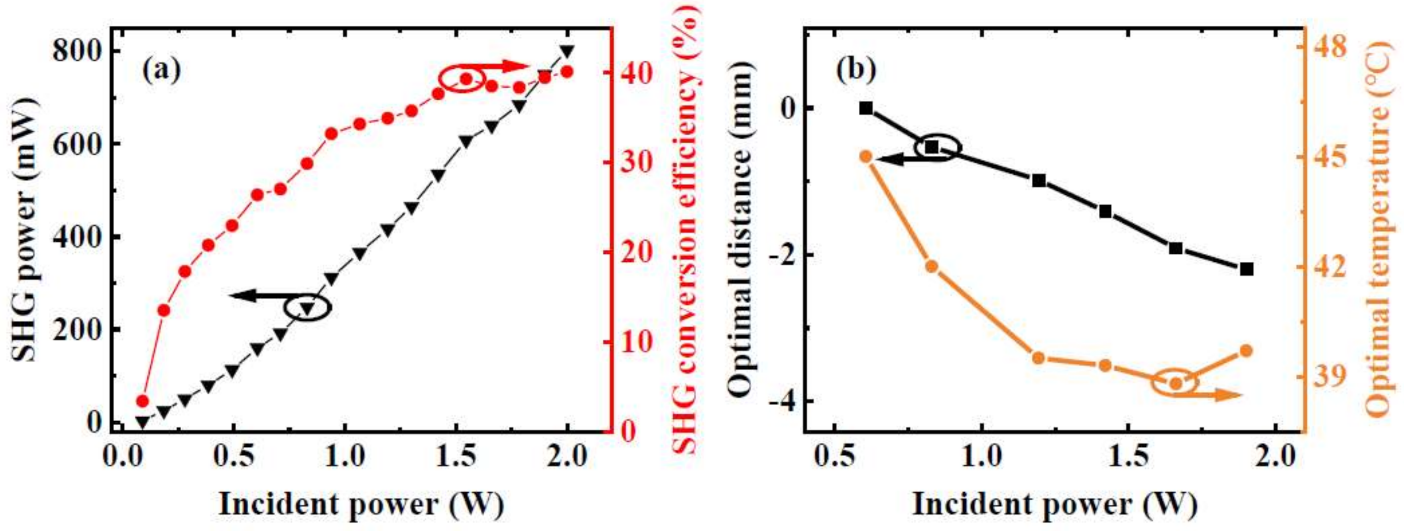
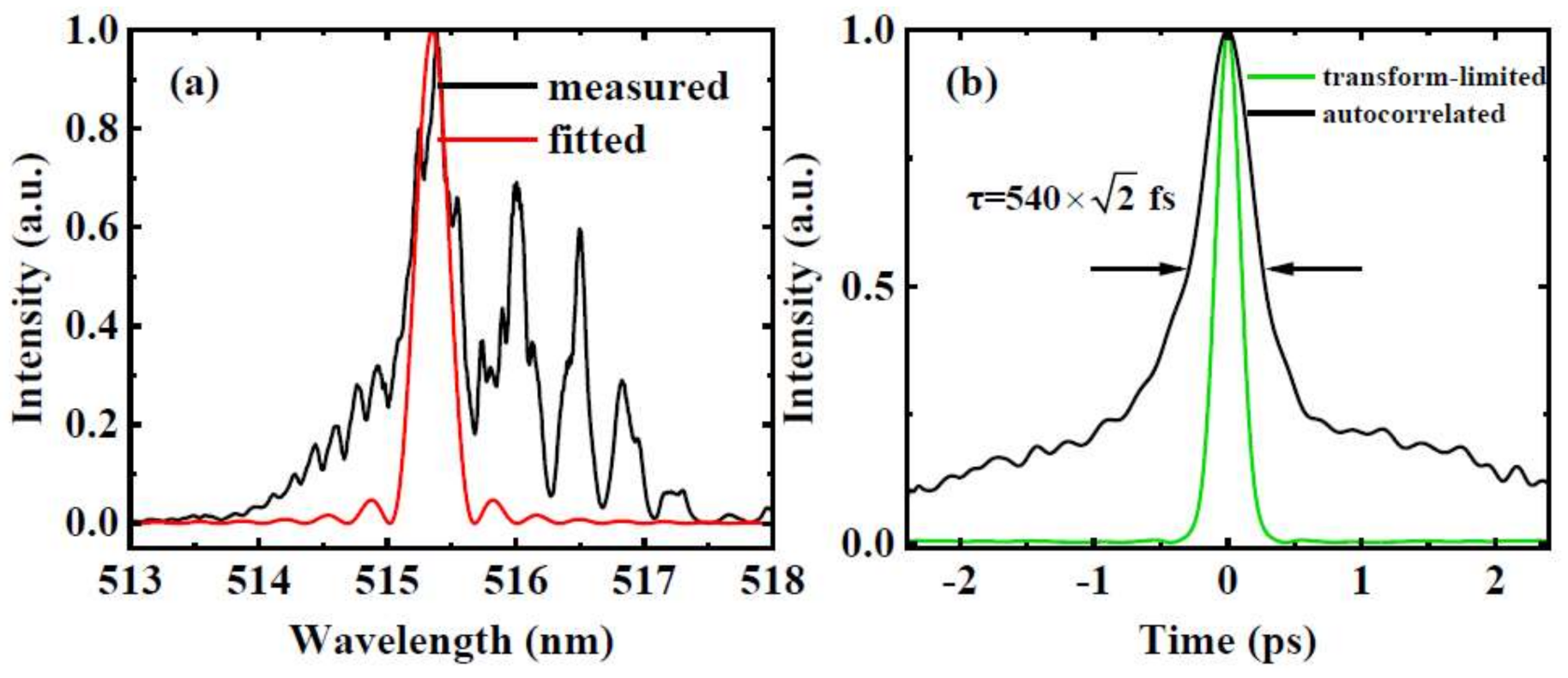
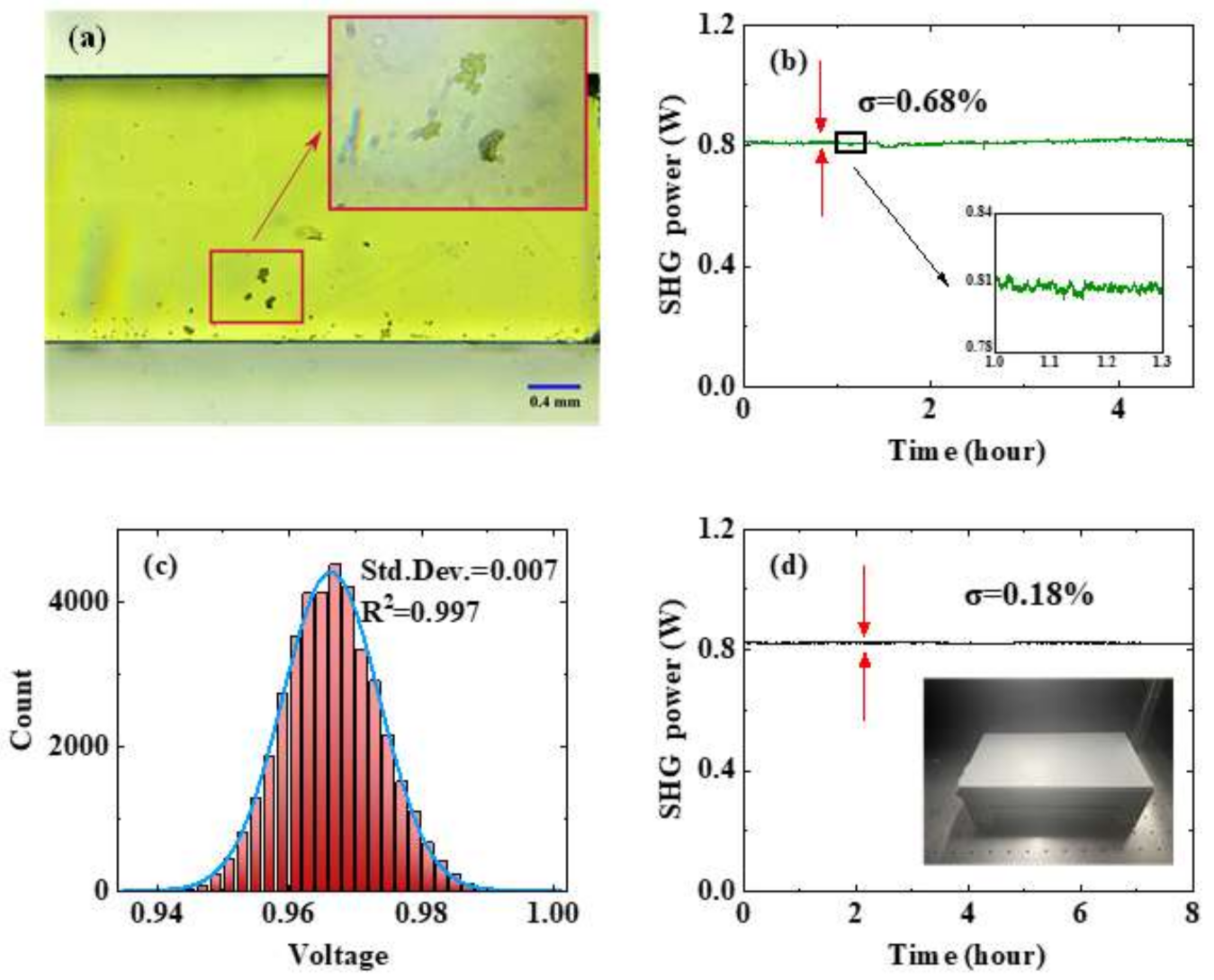
Publisher’s Note: MDPI stays neutral with regard to jurisdictional claims in published maps and institutional affiliations. |
© 2022 by the authors. Licensee MDPI, Basel, Switzerland. This article is an open access article distributed under the terms and conditions of the Creative Commons Attribution (CC BY) license (https://creativecommons.org/licenses/by/4.0/).
Share and Cite
Yu, B.; Hao, Q.; Tang, C.; Yang, K.; Chen, H.; Liang, W.; Zeng, H. Femtosecond Green Light Generation Using a MgO-Doped Periodically Poled Lithium Niobate Crystal Pumped by a Yb-Doped Fiber Laser. Appl. Sci. 2022, 12, 1391. https://doi.org/10.3390/app12031391
Yu B, Hao Q, Tang C, Yang K, Chen H, Liang W, Zeng H. Femtosecond Green Light Generation Using a MgO-Doped Periodically Poled Lithium Niobate Crystal Pumped by a Yb-Doped Fiber Laser. Applied Sciences. 2022; 12(3):1391. https://doi.org/10.3390/app12031391
Chicago/Turabian StyleYu, Binghao, Qiang Hao, Cheng Tang, Kangwen Yang, Huaixi Chen, Wanguo Liang, and Heping Zeng. 2022. "Femtosecond Green Light Generation Using a MgO-Doped Periodically Poled Lithium Niobate Crystal Pumped by a Yb-Doped Fiber Laser" Applied Sciences 12, no. 3: 1391. https://doi.org/10.3390/app12031391
APA StyleYu, B., Hao, Q., Tang, C., Yang, K., Chen, H., Liang, W., & Zeng, H. (2022). Femtosecond Green Light Generation Using a MgO-Doped Periodically Poled Lithium Niobate Crystal Pumped by a Yb-Doped Fiber Laser. Applied Sciences, 12(3), 1391. https://doi.org/10.3390/app12031391







